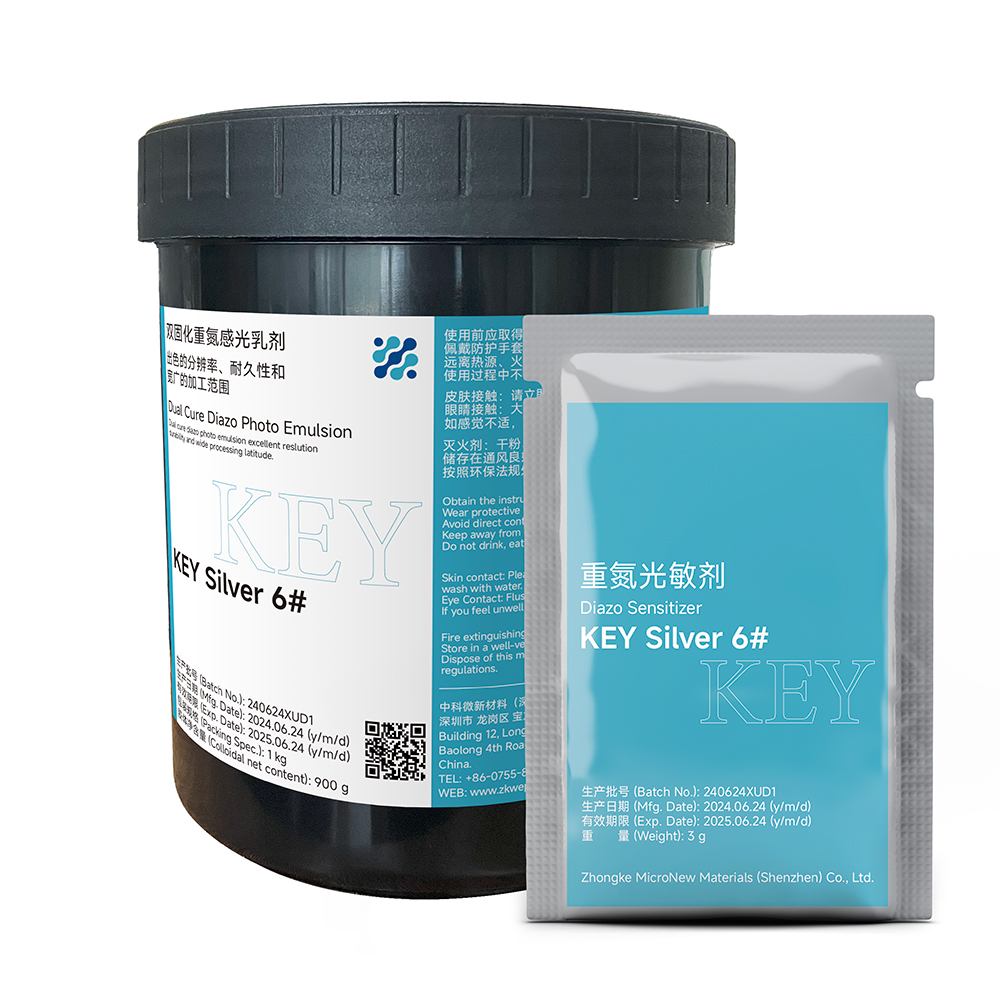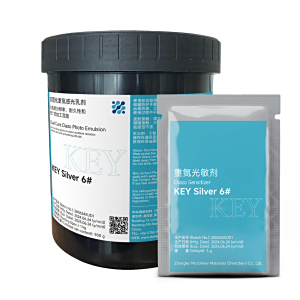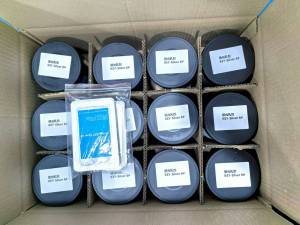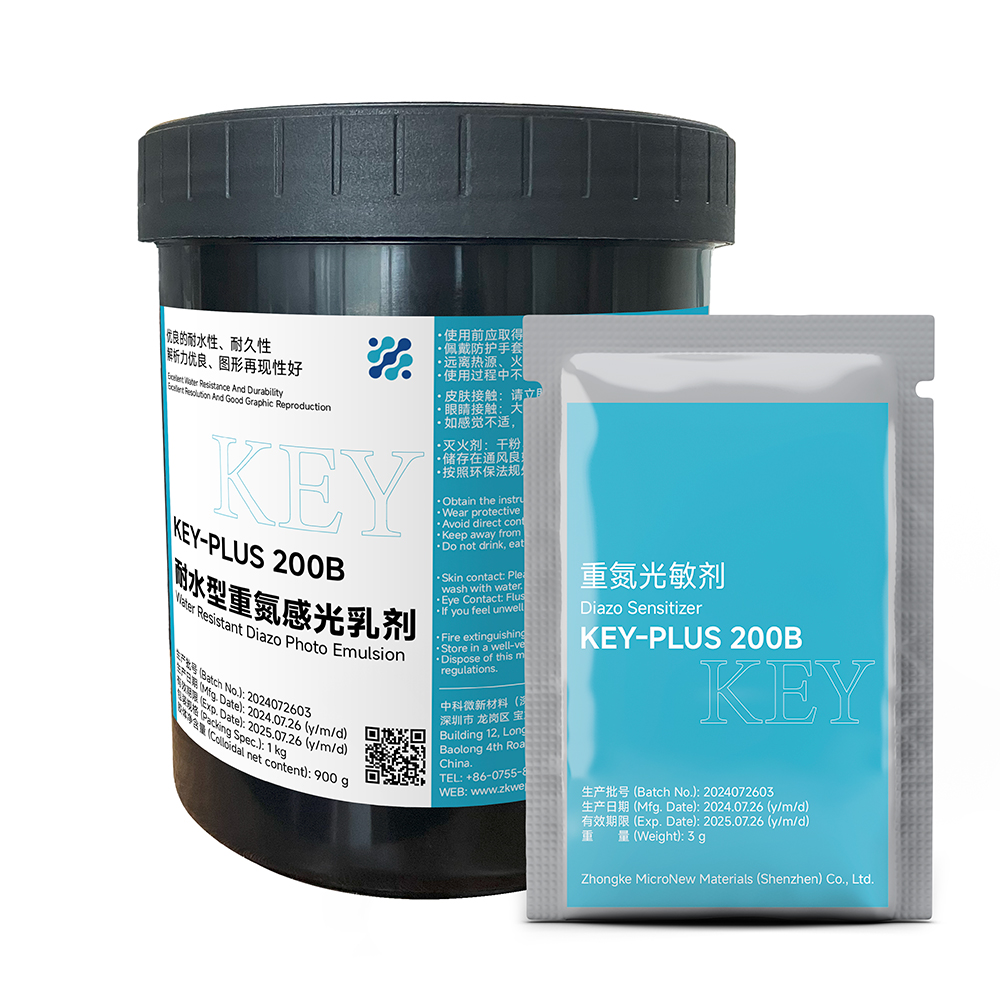
Scan the QR-code to get technical consultation immediately
KEY-Sliver 6# Solvent-Resistant, White Spot-Free Emulsion
Product Highlights
Comply with RoHS environmental directive | Excellent water and solvent resistance | High photosensitivity, exposure time |
High resolution, fine lines | High solid content, good leveling | Soft film to prevent ink seepage |
Product Description
Suitable for high-precision electronic products such as PCB, FPC, mobile phone cover, solar cell back electrode/back aluminum, and fine line and dot screen printing.
Product Parameters
Appearance | Specification | Emulsion Weight | Solid Content | Viscosity (mPa. s) B-type viscometer, 25°C | Diazo |
Blue Viscous Lotion | 1kg 5kg | 900g 4500g | 36% | 9000 | K7-3.0g |
曝光时间
Exposure Time | Angle | Film Thickness | Light Source | Light Distance | Optimal Exposure Time |
250T(Y) | 22.5° | 15±1µm | Ultra-High Pressure Mercury Lamp 3kw | 1m | 2.5 minutes |
It is recommended to perform secondary exposure after development, which can effectively increase the printing durability and improve the stripping properties.
使用方法
Sensitization: Dissolve diazo in about 70-100 grams of pure water. Then pour the diazo solution into the photosensitive glue, stir it thoroughly with a glass rod or a wooden stick, and use it after the bubbles disappear completely.
Coating: Use a high-quality scraper for coating. The characteristics of coating are related to the size and tension of the screen. Confirm the number of coating processes according to the needs of the printed matter to obtain the required film thickness. If more than 2 processes are required for coating, the next process must be carried out after the screen coated in the previous process is completely dry, otherwise it will cause the glue film to fall off.
Drying: It is best to control the drying temperature below 40℃. Too high a temperature will cause the photosensitive glue to produce a thermal reaction and affect the platemaking effect. The screen should be fully dried.
Exposure: The best light wave is 300-400nm. If an ultra-high pressure mercury lamp or a high-pressure gallium iodine lamp is used, the effect will be better.
Development: It is recommended to use a high-pressure water gun or a spray gun to rinse the plate at a uniform speed.
Drying: After development, first remove the moisture on the surface of the screen, and then put it in a drying oven below 40℃ for drying. It needs to be fully dried, otherwise the screen will easily fall off.
Secondary exposure: Expose the S side, and the exposure time is 1-2 times that of the P side, which can greatly improve the printing durability.
Hardening: After the screen is completely dry, evenly apply the mixed A+B hardening liquid on the P and S sides of the screen. After 1-2 minutes, use an air gun to blow through the lower ink area and dry for 20-30 minutes, which can greatly improve the printing durability of the screen.
Please Note
Photosensitive glue storage: Before sensitization, the storage temperature of the photosensitive glue colloid is best in a cold and dark place at 20℃. Do not store it in an environment above 25℃ or below 5℃, otherwise it is easy to produce chemical and physical changes, affecting normal use. Please store diazo in a refrigerator at 0-5℃.
Degreasing of the screen: Before applying the photosensitive glue, the screen should be thoroughly cleaned with a special degreasing agent to remove grease and dirt. After thorough cleaning and drying, high-quality screens can be obtained and the printing durability can be improved.
Diazo dissolution: Pure water or purified water should be used to dissolve diazo. If tap water is used directly, the minerals and water rust in the tap water will react chemically with the photosensitive glue, affecting the performance. In severe cases, the colloid will agglomerate and cannot be used normally.
Drying oven temperature: The temperature of the drying oven is best below 40℃. When it exceeds 40℃, the photosensitive glue is prone to thermal reactions, which reduces the resolution. The drying oven should have an exhaust device to discharge moisture in the box and improve the efficiency of complete drying of the screen. Check the temperature inside the oven every month to see if it is consistent with the set temperature. Check the temperature inside the oven every month to see if it is consistent with the set temperature.
Winter development: If the developing water temperature is too low in winter, it will cause poor screen development and reduced resolution. It is recommended to use warm water (25°C) for development.
Packing Specifications
Black thick plastic can: 1kg/can, 5kg/barrel









